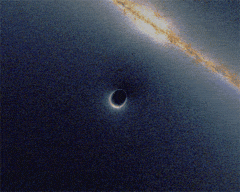
Back Singulariteit (sterrekunde) Afrikaans Singularität (Astronomie) ALS تفرد جذبوي Arabic Singularidá gravitacional AST Гравітацыйная сінгулярнасць Byelorussian Гравитационна сингулярност Bulgarian মহাকর্ষীয় অদ্বৈত অবস্থান Bengali/Bangla Esparder gravitadur Breton Singularitat gravitatòria Catalan Gravitační singularita Czech

| General relativity |
|---|
 |
A gravitational singularity, spacetime singularity, or simply singularity, is a theoretical condition in which gravity is predicted to be so intense that spacetime itself would break down catastrophically. As such, a singularity is by definition no longer part of the regular spacetime and cannot be determined by "where" or "when”. Gravitational singularities exist at a junction between general relativity and quantum mechanics; therefore, the properties of the singularity cannot be described without an established theory of quantum gravity. Trying to find a complete and precise definition of singularities in the theory of general relativity, the current best theory of gravity, remains a difficult problem.[1][2] A singularity in general relativity can be defined by the scalar invariant curvature becoming infinite[3] or, better, by a geodesic being incomplete.[4]
General relativity predicts that any object collapsing beyond its Schwarzschild radius would form a black hole, inside which a singularity will form.[2] A black hole singularity is, however, covered by an event horizon, so it is never in the causal past of any outside observer, and at no time can it be objectively said to have formed.[5] General relativity also predicts that the initial state of the universe, at the beginning of the Big Bang, was a singularity of infinite density and temperature.[6][obsolete source] However, classical gravitational theories are not expected to be accurate under these conditions, and a quantum description is likely needed.[7] For example, quantum mechanics does not permit particles to inhabit a space smaller than their Compton wavelengths.[8]
- ^ Earman 1995, pp. 28–31, Section 2.2 What is a singularity?
- ^ a b Curiel, Erik (2021). "Singularities and Black Holes". Stanford Encyclopedia of Philosophy. Metaphysics Research Lab, Stanford University. Retrieved 1 October 2021.
- ^ "Singularities". Physics of the Universe.
- ^ Uggla, Claes (2006). "Spacetime Singularities". Einstein Online. 2 (1002). Max Planck Institute for Gravitational Physics. Archived from the original on 2017-01-24. Retrieved 2015-10-20.
- ^ Narlikar, J. V.; Padmanabhan, Th. (June 1988). "The Schwarzschild solution: Some conceptual difficulties". Found Phys. 18. Springer Nature: 659–668. doi:10.1007/BF00734568.
- ^ Wald 1984, p. 99.
- ^ Hawking, Stephen. "The Beginning of Time". Stephen Hawking: The Official Website. Cambridge University. Archived from the original on 6 October 2014. Retrieved 26 December 2012.
- ^ Zebrowski, Ernest (2000). A History of the Circle: Mathematical Reasoning and the Physical Universe. Piscataway New Jersey: Rutgers University Press. p. 180. ISBN 978-0813528984.
